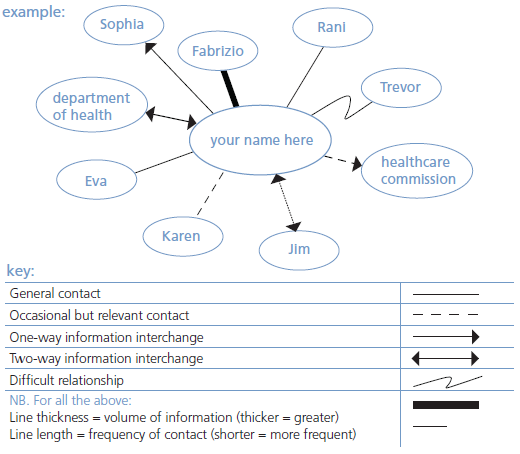Knowledge exchange
A tool to establish the level of knowledge being exchanged with different people with whom you have relationships.
Taking place when someone is moving on from their current position, it aims to recover unique and valuable information from them before they leave.
The knowledge exchange occurs between a knowledge holder and a facilitator. The knowledge holder is the person who is departing.
The facilitator is typically a line manager or trusted team member, who is close to the leaver and can ensure the questioning is of sufficient depth and relevance.
Ideally, the knowledge exchange will also involve the person replacing the knowledge holder or carrying out the tasks they leave behind. They will benefit from any useful tips and knowledge and from asking their own questions.
For more information see Knowledge management tools and techniques: helping you access the right knowledge at the right time.
Contact the Knowledge for Healthcare team on [email protected] for the document in an accessible format.
What are the benefits?
When staff leave an organisation they take with them the vital knowledge, experience and contacts they have built during their time there.
The organisation suffers if this information is not passed on before they leave.
Estimates suggest it takes at least six months before a new recruit contributes effectively to the organisation. Including checks of handover notes through the appraisal process protects organisational memory.
If a local authority adopted this approach, time and money saved per year would equate to between 10 and 100 posts.
Many organisations will already have some informal process in place to capture the knowledge of leavers. However, the best efficiency gains come from a formalised, structured knowledge exchange process.
How do I go about it?
Relationship Mapping Guide
To create a relationship map, please use an A4 plain piece of paper.
- In the centre of the paper draw a small circle or oval and write your name in the centre.
- Start mapping from the centre to the people, teams and organisations that you have relationships with in your working life. Please use full names and team titles.
- The closer to the centre of the page, the closer the relationship is.
- By drawing lines with different thickness you can demonstrate the amount of dialogue between the relationships. The thicker the line, the more regular the dialogue.

The diagram shows a space for 'you name' in the middle, From this radiate different lines linking to your contacts. Each line shows your relationship with the contact:
- solid lines with no arrows shows a general contact
- a dotted line with no arrows shows an occasional but relevant contact
- 1-way arrows show a one way flow of information
- 2-way arrows show a two-way flow of information
- a squiggle line shows a difficult relationship
The thickness of the line shows the volume of information being exchanged. The thicker, the more information.
The length of the line indicates the frequency of the contact. The shorter the line the more frequency of interaction with the contact.
Page last reviewed: 5 April 2024